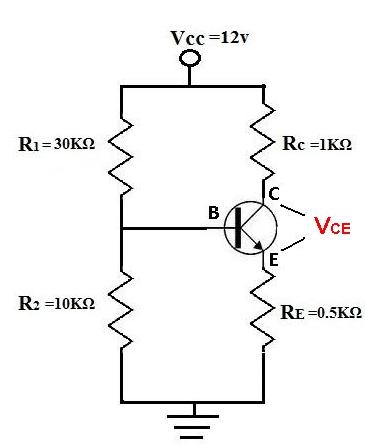

I B is through the base-emitter junction because of the low impedance path to ground and, therefore, I C is zeroįigure 9: Collector characteristic curves Thus, both the base-emitter junction and the base-collector junction are forward-biased because the base is at approximately 0.7 V while the emitter and the collector are at 0 V.

V BB is assumed to be set to produce a certain value of I B and V CC is zero. 8, a set of collector characteristic curves can be generated that show how I C varies with V CE, for specified values of I B.īoth V BB and V CC are variable sources of voltage. The voltage across the reverse-biased collector-base junction is.Since the drop across R C is V RC=I CR C, V C E can be written as.The voltage at the collector with respect to the grounded emitter is.Substituting for V RB and solving for I B, Since the emitter is at ground (0 V), by Kirchhoff’s voltage law, the voltage across R B is The characteristic of the base-emitter junction is the same as a normal diode curve. When the base-emitter junction is forward-biased,Īlthough V BE can be as high as 0.9 V in an actual transistor and is dependent on current, 0.7 V is used to simplify the analysis of the basic concepts. V BB forward-biases the base-emitter junction, and V CC reverse-biases the base-collector junction. V C E: DC voltage at collector with respect to emitter V CB: DC voltage at collector with respect to base V BE: DC voltage at base with respect to emitter Figure 7: Transistor currents and voltages

The operation of the pnp is the same as for the npn except that the roles of the electrons and holes, the bias voltage polarities, and the current directions are all reversed.Ĭonsider the basic transistor bias circuit in Fig. The emitter current is slightly greater than the collector current because of the small base current that splits off from the total current injected into the base region from the emitter.
Transistor biasing calculator free#
The free electrons move through the collector region, into the external circuit, then return into the emitter region along with the base current. When the electrons that have recombined with holes leave the crystalline structure of the base, they become free electrons in the metallic base lead and produce the external base current.Īs the free electrons move toward the reverse-biased BC junction, they are swept across into the collector region by the attraction of the positive collector supply voltage. The base has a low density of holes, which are the majority carriers.Ī small percentage of the total number of free electrons injected into the base region recombine with holes and move as valence electrons through the base region and into the emitter region as hole current.įigure 4: BJT operation showing electron flow These free electrons easily diffuse through the forward-based BE junction into the lightly doped and very thin p-type base region. The heavily doped n-type emitter region has a very high density of conduction-band (free) electrons. The base region is lightly doped and very thin compared to the heavily doped emitter and the moderately doped collector regions.įigure 2 shows the schematic symbols for the npn and pnp bipolar junction transistors. The leads are labeled E, B, and C for emitter, base, and collector, respectively. The pn junction joining the base region and the collector region is called the base-collector junction.Ī wire lead connects to each of the three regions. The pn junction joining the base region and the emitter region is called the base-emitter junction. The term bipolar refers to the use of both holes and electrons as current carriers in the transistor structure. One type consists of two n regions separated by a p region (npn), and the other type consists of two p regions separated by an n region (pnp). The BJT is constructed with three doped semiconductor regions ( emitter, base, and collector) separated by two pn junctions.


 0 kommentar(er)
0 kommentar(er)
